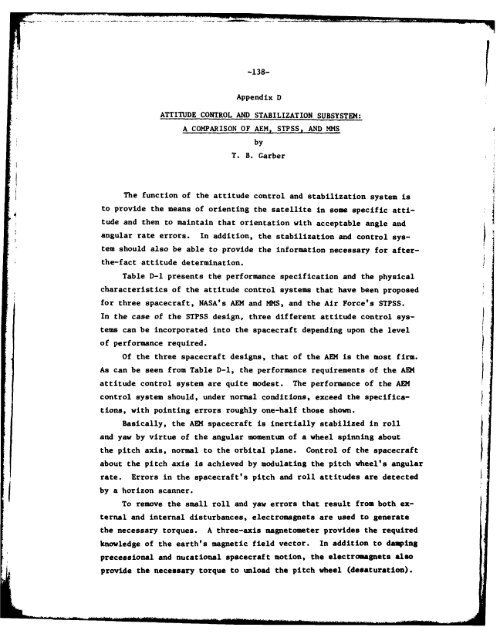A Case Study in NASA-DoD - The Black Vault
A Case Study in NASA-DoD - The Black Vault
A Case Study in NASA-DoD - The Black Vault
Create successful ePaper yourself
Turn your PDF publications into a flip-book with our unique Google optimized e-Paper software.
-138-<br />
Appendix D<br />
ATTITUDE CONTROL AND STABILIZATION SUBSYSTEM:<br />
A COMPARISON OF AEM, STPSS, AND MMS<br />
by<br />
T. B. Garber<br />
<strong>The</strong> function of the attitude control and stabilization system is<br />
to provide the means of orient<strong>in</strong>g the satellite <strong>in</strong> some specific attitude<br />
and then to ma<strong>in</strong>ta<strong>in</strong> that orientation with acceptable angle and<br />
angular rate errors. In addition, the stabilization and control system<br />
should also be able to provide the <strong>in</strong>formation necessary for afterthe-fact<br />
attitude determ<strong>in</strong>ation.<br />
Table D-I presents the performance specification and the physical<br />
characteristics of the attitude control systems that have been proposed<br />
for three spacecraft, <strong>NASA</strong>'s AEM and MMS, and the Air Force's STPSS.<br />
In the case of the STPSS design, three different attitude control systems<br />
can be <strong>in</strong>corporated <strong>in</strong>to the spacecraft depend<strong>in</strong>g upon the level<br />
of performance required.<br />
Of the three spacecraft designs, that of the AEM is the most firm.<br />
As can be seen from Table D-l, the performance requirements of the AEM<br />
attitude control system are quite modest. <strong>The</strong> performance of the AEM<br />
control system should, under normal conditions, exceed the specifications,<br />
with po<strong>in</strong>t<strong>in</strong>g errors roughly one-half those shown.<br />
Basically, the AEM spacecraft is <strong>in</strong>ertially stabilized <strong>in</strong> roll<br />
and yaw by virtue of the angular momentum of a wheel sp<strong>in</strong>n<strong>in</strong>g about<br />
)<br />
the pitch axis, normal to the orbital plane. Control of the spacecraft<br />
about the pitch axis is achieved by modulat<strong>in</strong>g the pitch wheel's angular<br />
rate. Errors <strong>in</strong> the spacecraft's pitch and roll attitudes are detected<br />
by a horizon scanner.<br />
To remove the small roll and yaw errors that result from both external<br />
and <strong>in</strong>ternal disturbances, electromagnets are used to generate<br />
the necessary torques. A three-axis magnetometer provides the required<br />
knowledge of the earth's magnetic field vector. In addition to damp<strong>in</strong>g<br />
precessional and nucational spacecraft motion, the electromagnets also<br />
provide the necessary torque to unload the pitch wheel (desaturation).
















